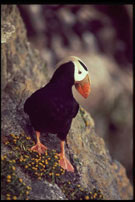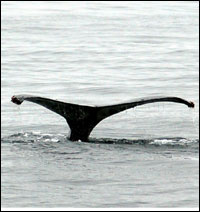|
by Walter Bonora and Mary Jane Schramm
National Marine Sanctuaries
Locals refer to the Farallon Islands as the place where the “big boys” hang out – big as in humpback and gray whales, white sharks, elephant seals, and the occasional blue whale. Locals also refer to the islands as the westernmost neighborhood of San Francisco, 27 miles beyond the Golden Gate Bridge.
But the Farallones are more than just a feeding ground for giant marine life. The islands form the centerpiece of Gulf of the Farallones National Marine Sanctuary -- 1,255 square miles of protected waters off the northern and central California coast that is managed by the NOAA National Marine Sanctuary Program.
The islands are also home to Steller sea lions, and to a quarter-million nesting seabirds, – the largest seabird rookery in the contiguous United States. And it was to those islands we ventured on a late August morning under dense, gray skies.
 |
| Whale with tour boat. (Photo: Walter Bonora) |
|
|
Boarding the Lovely Martha, a SF Bay Whale Watching boat, we set out on a day that would hold several wonderful surprises, and some not so wonderful.
The good news – we saw a staggering array of wildlife. The journey unfolded like an adventure film, beginning slowly, as we cruised out the Gate spotting the occasional commorant, past fat harbor seals draped over the rocks at Point Diablo, and then rising to a climax with the appearance of majestic humpbacks.
Calm seas enabled us to see dozens of usually shy harbor porpoises, with dorsal fins like a Hershey’s kiss. This species was once threatened with gillnet entanglement, but now thrives in nearshore waters.
As we made our way into open water, we spotted more cormorants, murres and gulls. Brown pelicans nose-dived for fish. We passed a blue shark circling at the surface and couldn’t help wonder what it was circling. A frisbee-shaped ocean sunfish basked on the water, and then, after a bonanza of seal, porpoise and seabird sightings, the Farallones rose out of the mist -- stark, jagged, and ominous -- like King Kong’s Skull Island.
Soon after, the humpbacks emerged from the water – “humpies” as our skipper, Frank Rescino, referred to them. They seemed to tease us for a while, taking their time before taking center stage on this vast ocean landscape.
These animals never cease to amaze. They dwarfed the boat and yet showed no signs of hostility to the visitors eager to photograph them.
An Australian tourist noted, “We thought maybe we would see one whale in the distance; never did we imagine we would see this many humpbacks up close, so close we could smell their blow. Whale breath!"
 |
| Tufted puffin. (Photo: Jeff Foote) |
|
|
As we neared the islands, we spotted colorful tufted puffins floating on the surface. Only about a hundred of these birds nest in the islands’ rocky burrows. Our skipper brought us in closer and we could see barking sea lions and screaming seabirds.
In addition to the thousands of nesting seabirds, the Farollones host a return resident. After nearly 170 years, the islands are once again a breeding colony for northern fur seals. Like many California critters, fur seals were once hunted to the brink of extinction. Now they have found a haven on a national wildlife refuge surrounded by food-rich sanctuary waters.
“The Farallones are the ultimate seal and seabird bed and breakfast,” noted Doreen Gurrola, naturalist on board the Lovely Martha. “The waters feed them; the land provides a place for the animals to nest or breed, and the islands’ jagged rocks deliver a strong ‘Do Not Disturb’ message to human interlopers.”
But now, the bad news. The darker side of the trip was encountering numerous party balloons floating on the water - a stark reminder that the health of our oceans remains in constant peril, and requires our continued vigilance.
“Much of the debris that plagues the ocean comes from land,” said Gurrola. “Balloons are of major concern because they look like jellyfish to the marine animals that feed on those creatures. And when they ingest a balloon, the animals often choke, such as the critically endangered leatherback turtles that eat jellies. With the Pacific population of these turtles headed for possible extinction, we can’t afford to lose even one to our carelessness.”
Captain Rescino changed course several times to retrieve the balloons. The key here is that many commercial outfitters are not just looking to stay on a schedule. They keep a vigilant eye out for debris, and will alter their itinerary to remove as much as they can. They take their living from the sea. They respect it. On our trip, the skipper’s enthusiastic son and deckhand, Michael, didn’t miss a single balloon in our path.
 |
| Whale fluke. (Photo: Walter Bonora) |
|
|
On the way back, Gurrola nicely recapped the wildlife spotted, and encouraged those aboard to keep alive the experience we shared that day. Her final message to us was that we can all lend a hand in keeping our oceans clean and healthy. One little thing can make a difference – whether it is using biodegradable detergents, recycling, or maybe driving a hybrid.
“All of us can do something,” she added, “even if just one thing to improve the health of our ocean. It all comes down to making that vital, personal connection with our blue planet.”
Gulf of the Farallones National Marine Sanctuary was designated in 1981. Since its creation, sanctuary staff have played a vital role in protecting the local marine environment, responding to oil spills and other environmental emergencies, monitoring the health and abundance of endangered species, and lending an important voice to ensuring a healthy marine ecosystem. To learn more about this special place and to travel to these remote islands, visit www.farallones.noaa.gov, and www.farallones.org.
|





